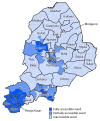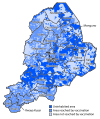Progress Toward Poliomyelitis Eradication - Nigeria, January-December 2017
- PMID: 29494568
- PMCID: PMC5861699
- DOI: 10.15585/mmwr.mm6708a5
Progress Toward Poliomyelitis Eradication - Nigeria, January-December 2017
Abstract
Nearly three decades after the World Health Assembly launched the Global Polio Eradication Initiative in 1988, four of the six World Health Organization (WHO) regions have been certified polio-free (1). Nigeria is one of three countries, including Pakistan and Afghanistan, where wild poliovirus (WPV) transmission has never been interrupted. In September 2015, after >1 year without any reported WPV cases, Nigeria was removed from WHO's list of countries with endemic WPV transmission (2); however, during August and September 2016, four type 1 WPV (WPV1) cases were reported from Borno State, a state in northeastern Nigeria experiencing a violent insurgency (3). The Nigerian government, in collaboration with partners, launched a large-scale coordinated response to the outbreak (3). This report describes progress in polio eradication activities in Nigeria during January-December 2017 and updates previous reports (3-5). No WPV cases have been reported in Nigeria since September 2016; the latest case had onset of paralysis on August 21, 2016 (3). However, polio surveillance has not been feasible in insurgent-controlled areas of Borno State. Implementation of new strategies has helped mitigate the challenges of reaching and vaccinating children living in security-compromised areas, and other strategies are planned. Despite these initiatives, however, approximately 130,000-210,000 (28%-45%) of the estimated 469,000 eligible children living in inaccessible areas in 2016 have not been vaccinated. Sustained efforts to optimize surveillance and improve immunization coverage, especially among children in inaccessible areas, are needed.
Conflict of interest statement
No conflicts of interest were reported.
Figures
References
-
- Global Polio Eradication Initiative. Semiannual report on the progress against the Polio Eradication and Endgame Strategic Plan. Geneva, Switzerland: World Health Organization; 2017. http://polioeradication.org/wp-content/uploads/2017/12/WHO-Polio-Donor-R...
-
- World Health Organization. WHO removes Nigeria from polio-endemic list. Geneva, Switzerland: World Health Organization; 2015. http://www.who.int/mediacentre/news/releases/2015/nigeria-polio/en/
MeSH terms
Substances
LinkOut - more resources
Full Text Sources
Other Literature Sources
Medical



